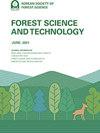Thirty-two years of mangrove forest land cover change in Parita Bay, Panama
IF 2.2
Q2 FORESTRY
引用次数: 7
Abstract
Abstract Mangrove forests have experienced a rapid decline. However, the rate of loss has decreased in recent years due to enhanced conservation and nature regeneration. The dynamics of mangrove forests in Panama have not been monitored since the year 2000, despite a significant loss during the 1980s. The objectives of our study were to quantify changes in mangrove cover and identify the dominant drivers of change in Parita Bay, Panama. Temporal changes in mangrove cover and the Normalized Difference Vegetation Index (NDVI) were determined using the supervised classification method on Landsat satellite images from 1987 to 2019. We identified a 4.7% increase in the mangrove area of Parita Bay during the 32 years; the mangrove forests were also considered healthy as reflected by high NDVI values. However, the conversion of mangroves to other land cover types resulted in a 1.26% decline in mangrove cover from 1987 to 1998. Moreover, the area of aquaculture and saltpans almost doubled during this period. During the following two decades, the conversion of other land cover classes (water, other vegetation, and bare soil) increased the mangrove area by 6%, and the annual rate of increase was greater during the second decade (0.43% year−1). From 2009 to 2019, mangroves declined at an annual rate of 0.11% in protected areas and increased at an annual rate of 0.50% in unprotected areas. Despite the regeneration potential of mangrove forests, our study highlights the need to continually manage and protect mangrove forests in order to facilitate their expansion in Parita Bay.巴拿马帕里塔湾32年来红树林土地覆盖变化
红树林经历了快速的衰退。然而,近年来,由于加强保护和自然更新,损失率有所下降。巴拿马红树林的动态自2000年以来一直没有受到监测,尽管在1980年代期间损失了大量红树林。本研究的目的是量化巴拿马Parita湾红树林覆盖的变化,并确定变化的主要驱动因素。采用监督分类方法对1987 - 2019年Landsat卫星影像进行了红树林覆盖度和归一化植被指数(NDVI)的时序变化分析。我们发现,在32年间,Parita湾的红树林面积增加了4.7%;红树林也被认为是健康的,这反映在高NDVI值上。然而,从1987年到1998年,红树林向其他土地覆盖类型的转变导致红树林覆盖减少了1.26%。此外,在此期间,水产养殖和盐田面积几乎翻了一番。在接下来的20年里,其他土地覆盖类型(水、其他植被和裸土)的转换使红树林面积增加了6%,第二个10年的年增长率更大(0.43%)。从2009年到2019年,受保护地区的红树林以每年0.11%的速度减少,而未受保护地区的红树林以每年0.50%的速度增加。尽管红树林具有再生潜力,但我们的研究强调了持续管理和保护红树林的必要性,以促进它们在帕里塔湾的扩张。
本文章由计算机程序翻译,如有差异,请以英文原文为准。
求助全文
约1分钟内获得全文
求助全文

 求助内容:
求助内容: 应助结果提醒方式:
应助结果提醒方式:


